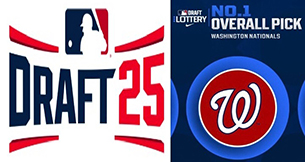
Remember when Washington Nationals’ principal owner Mark Lerner was photographed with his former-World Series outfielder, Juan Soto, before Dylan Crews‘ MLB debut game? Many thought that was a good sign that the Nationals had a shot to sign Soto. That shot was served in a highball glass with a jolt of reality and a bitter lemon.
Maybe the the consolation prize on Soto was not falling in the trap of the Yankees, thinking they could retain him for the rest of his career. They failed to extend his contract and then couldn’t sign him as a free agent. All the Yankees got for their going-away present was a compensatory draft pick after the third round. But the Bronx Bombers also had to endure the embarrassment of seeing Soto go across the borough to Queens. At least the Nats got an absolute queen’s haul of MacKenzie Gore, CJ Abrams, James Wood who combined for +6.3 WAR last year — and Wood only played half the season! Add to the haul the two other players the Nats received in the trade with Top-100 prospect Jarlin Susana and former Top-100 prospect Robert Hassell III.
Look, the Yankees, Red Sox, and other teams didn’t get Soto either. He took the biggest offer at $765 million in total at $51 million a year with the Mets. That would have crushed a small market revenue team like the Washington Nationals, and most other teams also. Reality sucks. This contract is the largest in professional sports history, and in addition, his contract can actually increase to $805 million. Here is how that would work: If Soto asks for an opt-out from his contract after five years — the Mets can increase his salary by $4 million per year to retain him for the final 10 seasons to bring the contract to $805 million.
Speaking of a haul, Lerner spoke today in a story covered in the Washington Post, and said “We’re in it for the long haul.” But much of what he said was typical Lerner speaking lines from their playbook of promising nothing concrete but giving a sliver of hope. There is no carnival barker or salesman in the guy. But at least he didn’t give one of those talks of B.S. promises, or gloom and doom. He acknowledged the progress. Everyone’s mileage will vary on it from one extreme to the other — and most will be in the middle on wait-and-see.
“Our commitment is to continue to go forward. [A sale is] not on the list of things we worry about. We’re excited about the team. We worked too hard to get it, and we love what we’re doing with it. And so, unless something different happens along the way, we’re in it for the long haul.”
— Lerner said today
“… But at the end of the day, it wasn’t worth the aggravation of [selling part of the team] and having more partners and all that. So we kept it, and we’re working hard to work out all the issues — MASN and everything else.”
On the fact the Nats didn’t spend to get that hundred million dollar player:
“When Mike [Rizzo] calls me in and says, ‘We really need to think about it,’ for next winter, we’ll talk about it. Right now, he doesn’t think — and I agree with him: There’s no point in getting a superstar and paying him hundreds of millions of dollars to win two or three more games. You’ve got to wait until — like [acquiring] Jayson Werth, [when the team] was right on the cusp of being really good, and it took us to the next level. That’s the ideal situation. It’s always on our mind.”
While Lerner did acknowledge the MASN debacle, he did not go into detail. The sides are back in court again, and the Nats suffered a huge hit when they learned that going back retroactively to 2024 and moving forward that they were going to receive over $14 million less annually in their annual TV rights’ fees from MASN.
Also, Lerner didn’t name names of the free agents, however clearly it would have made no sense to sign a player like Alex Bregman for a net-WAR gain of 3.2 (4.1 minus 0.9 for Jose Tena) on a deal that paid him $40 million and included a one-year opt-out which really only works for a team with World Series aspiration this year. The Nats do need long-term solutions, not the one-year and two-year commitments like they have been doing in their rebuild. To come out of the rebuild, they really need long-term smart solutions — and as general manager Mike Rizzo stressed, they need to know what stars they have before they know which holes they have to fill. Get to being a 79-win team in actuality, then you add a net-WAR of 7.0 for two stars, and you are a playoff contender at 86-wins. By the way, the Red Sox after the Bregman acquisition are projected at 85-wins by FanGraphs.
But fans want to know why Rizzo’s message changed from the Winter Meetings when the Nats’ GM said “hit the gas.” But doesn’t it feel like they pumped the brakes?
“We feel good where we’re at, and have a fertile [farm] system with guys who will help us in 2025 and beyond, but we have to keep moving forward and hit the gas, and supplement the young core of guys we have.”
— Rizzo wanted to “hit the gas” as he said at the Winter Meetings
Here’s the thing, the Nats have spent over $41 million to add to this year’s payroll so far for Nathaniel Lowe, Michael Soroka, Trevor Williams, Josh Bell, Jorge Lopez, Shinnosuke Ogasawara, Amed Rosario, Paul DeJong and Evan Reifert. If a player like Colin Poche makes the team, add his salary to the total. There was plenty of money there to sign any free agent not named Soto, but Rizzo went for a quantity of good players instead of shooting most of his wad on two to three players. This is where the misconception is.
The Nationals spent more money than 14-teams. They just didn’t get a marquee player. When you don’t do that, you lose excitement with parts of your fan base, and you lose in the ticket sales. But most analysts agree that the Nats improved their roster over last year. Rizzo and Lerner hope for more upside than the analysts have given them from 73-to-76 wins in various projections. That is still an improvement over the 71 from last year.
Rizzo spoke about the three behemoths in the NL East division, but also about the teams that have the revenues to spend $300 to $400 million on payroll.
Rizzo specifically said that they weren’t signing QO’d players based on weighing the forfeiture of their second round draft pick this year plus losing $500,000 from their international free agency bonus pool.
Rizzo spoke about the need to get his “[prospect] stars to be [MLB] stars” so you can go into the next phase of adding long-term players from outside the organization.
For those hoping the Lerners would sell the team to some mythical owner who would swoop in and make everyone happy — that is the stuff in fairy tales. A new owner might spend money quickly for the public relations’ boost then probably go back to prudency, unless you got an owner like Steve Cohen of the Mets. The jury is out on him for now. Yes, he spends, but many Mets fans have taken issue that the team has too many holes. How many fans are really happy with their ownership?
When Spring Training camp opened, Rizzo did say he would like to add to his bullpen, and he went through the offseason “without blowing up the budget.” We have reported before that we believe the budget was about $50 million after guidance from a source led us to that number. As of this writing, Rizzo has spent $41 million so far.
“The [salaries] of the players on the field is about the same, if not a little less, than it was last year. But I think that we have a better team than we had last year. We filled in a bunch of spots that we needed to fill without expanding … the budget too much, and blocking prospects too much. And I think we’ve improved the club. I think we’ll go from a competitive team last year to a real tough team to play this year … We did all of this without blowing up the budget.”
— Rizzo said last week
“Obviously, the payroll that we have to allocate to players has something to do with [long-term payroll], but there’s other factors that also come into that [because] we had a plan of what we were trying to do, and our blueprint was … we didn’t want to block any prospects that we feel are going to be our future players, and we didn’t want to [sign QO’d players] and give up any draft picks or any international money, which is important to us at this stage.”
Fact check on Rizzo, the Nats’ Competitive Balance Tax (CBT) payroll stands today at $126 million today. Last year, the payroll was at $138.3 million to finish the season. So no, the salaries are not the same or a little less.
Now there was a lot of unperforming payroll off the books from the 2024 roster to where Rizzo got a boost from addition by subtraction. He also signed players below market value as the free agent market softened, and if you look at Lowe’s value per FanGraphs, he was worth $22.5 million in $/WAR output last year versus his arb salary as a fifth year player of $10.3 million for this year. That would be $12.2 million of excess value. This is why judging a young team by its payroll is a fool’s errand. The Orioles’ CBT payroll in 2023 was $89.4 million according to Baseball Prospectus, and they won 101 games in 2023 against estimates of 79 wins.
What we also do not know is whether Rizzo wants to extend the contracts of any of his young players. That would be additive to the spending if any of that hits this year. Rizzo has already talked about the continuity of his roster to compete as a winning team. Also, there is the unknown if the Nats will sign some top free agents next year. That will get a lot of fingers pointed at the Lerner ownership group. The time is ticking on the current roster to look at future windows to compete. Nobody asked Rizzo about contract extensions for core players. We will revisit all of this again soon.









